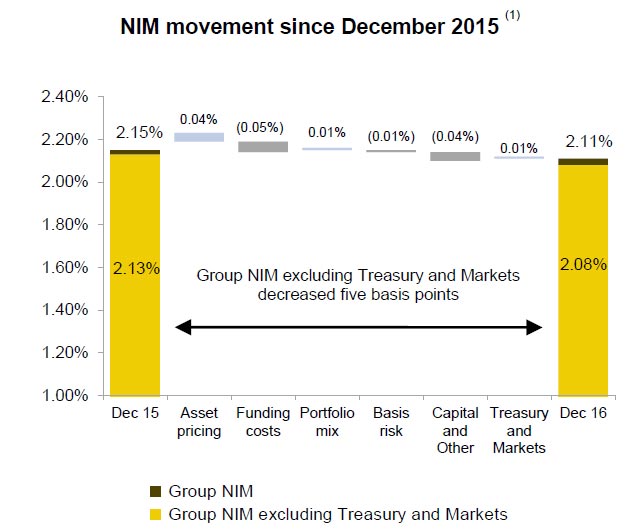A figure deep in the Commonwealth Bank’s latest billion-dollar result heralds more rate pain for indebted households in 2017, even if the Reserve Bank doesn’t touch the cash rate.
 Australians who can afford it are saving like crazy for fear the big banks will keep hiking mortgage rates. And it seems they are right to be worried, as rising wholesale and regulatory costs tempt lenders to claw back funds from owner-occupiers.
Australians who can afford it are saving like crazy for fear the big banks will keep hiking mortgage rates. And it seems they are right to be worried, as rising wholesale and regulatory costs tempt lenders to claw back funds from owner-occupiers.
On Wednesday, CBA posted a half-year (July-Dec) net profit after tax of $4.89 billion.
But its net interest margin (NIM) – the difference between what the bank pays for funding and what it charges on loans – fell to 2.11 per cent in the first half of the 2017 financial year, down from 2.14 per cent in the full 2016 fiscal year.
Add in the requirement from regulator APRA that banks hold more capital to protect against a crisis and there are strong signs that borrowers will soon be slugged.
Finance analyst Martin North said he expected the big lenders to continue lifting rates this year, even if the RBA cash rate stayed at a record-low 1.5 per cent.
“The real conversation here is not what the RBA does because the official cash rate has very little to do with what real mortgage holders are experiencing. We have already seen, and we will see more, out-of-cycle interest rate rises,” Mr North told The New Daily.
Much of the recent media focus has been on a crackdown by CBA and its subsidiary, BankWest, on investor lending. CBA slammed on the brakes even harder on Wednesday by lifting its interest-only home loan rate, targeted at investors, by 12 basis points to 5.68 per cent.
The average Australian may rejoice at this, as many believe investors squeeze out first home buyers.
The fear, however, is that the big banks, deterred by the regulator from writing too many investor loans and forced by competitive pressures to leave deposit rates alone, will target owner-occupiers for what Mr North called “margin repair”.
 As the chart above shows, fixed and variable rates have been pushed very low by the Reserve Bank’s heavy cuts to the official cash rate in recent years, intended to stoke the economy during the post-GFC slump.
As the chart above shows, fixed and variable rates have been pushed very low by the Reserve Bank’s heavy cuts to the official cash rate in recent years, intended to stoke the economy during the post-GFC slump.
But if readers look closely at the bottom right of the chart, they’ll see rates are trending up.
Data supplied to The New Daily by RateCity shows that while the average variable rate at the big four banks crept up by only one basis point over the last six months, the average fixed rate is now six basis points higher than in September last year.
The bigger concern for Australians is rising variable rates. About 85 per cent of current borrowers are on variable, which means any rise will hit their household budgets immediately.
 In a recent research note, JP Morgan identified rising mortgage servicing costs as the “most immediate challenge” facing Australian households.
In a recent research note, JP Morgan identified rising mortgage servicing costs as the “most immediate challenge” facing Australian households.
The bank also noted that households seem to be stockpiling a “handy cash buffer” in their bank accounts “to help insulate against unexpected income and liquidity shocks”.
But Mr North noted that not all households are so well prepared.
“There are some households who are very well protected because they’ve been repaying more than they needed to on their mortgages when interest rates dropped and they’ve been saving more,” he said.
“But there are other households that are actually up to their gills in debt and have no ability to effectively make those forward bets on the market.
“And it’s not just battlers on the outskirts of cities. There are some younger, more affluent people who have bought high-rise apartments quite recently who’ve got really large mortgages and are highly leveraged and have got almost no other assets.”
Watch the central banks
The excuse from the big lenders is that it is getting more expensive to borrow wholesale funds from overseas.
Despite what readers may have heard, the Reserve Bank’s official cash rate – the one it announces with much fanfare on the first Tuesday of every month except January – is not the only impact on the cost of lending.
This was demonstrated in a soon-to-be-published, five-year study by Australian academics Drs Simon Cottrell and Sigitas Karpavicius, a draft of which has been provided to The New Daily.
Using a sample of 1711 bond issues in five currencies by Australia’s big four banks, the academics found that the cost of wholesale funding (which contributes about 40-50 per cent of the total funding of banks) is mainly driven by international monetary policy, while the impact of the RBA’s cash rate is “insignificant”.
The US Federal Reserve is starting to lift rates, and other important central banks may soon follow, which means wholesale funding costs will continue to rise, if this study is correct.
So the big lenders have a good excuse to push up rates outside of the RBA cash rate – and households have good reason to be worried.

